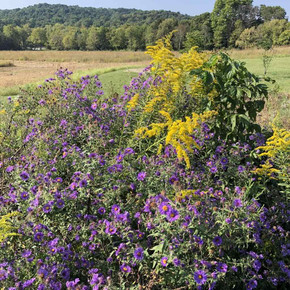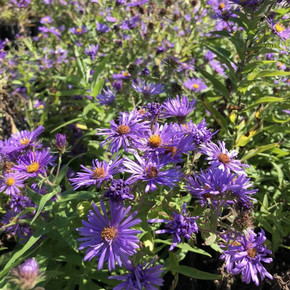
Aster laevis 'Bluebird' (Symphyotrichum) - SMOOTH ASTER 'BLUEBIRD'
From the Mt. Cuba research center:
"A Mt. Cuba Center Plant Introduction. Ranked as the #1 aster in an evaluation study at Mt. Cuba Center, this herbaceous perennial produces abundant, violet blue flowers on 3-4’ tall stems as fall color begins in the surrounding forest. It has attractive, slightly glossy, bluish-green foliage that is virtually pest-free. Bluebird smooth aster thrives in full sun to light shade with a broad tolerance of soil types and moisture levels. It makes an excellent perennial border specimen, meadow component or used in mass plantings. Some good companions include Schizachyrium scoparium, Andropogon virginicus, Rudbeckia fulgida, Eutrochium purpureum ‘Big Umbrella’, Euthamia caroliniana, Solidago rugosa 'Fireworks', and Helianthus angustifolius.
"'Bluebird' was discovered in 1988 in a Guilford, Connecticut garden as a spontaneously occurring seedling. It was first introduced to the trade in 1994."
An excellent selection that provides a pop of contrast in early to late fall. Drought tolerant. Great cut flower.
Blooming Time: September - October
Size: 2-3’ tall x 2-4’ wide
USDA Zones: 4 to 8
Culture: full to part sun, tolerant to many types of soil including shallow, rocky soils
Moisture Needs: medium to dry
Origin: the native Aster laevis is found throughout the US and most of Canada (USDA distribution map) growing in prairies, savannas, well drained woodlands, dry open woods and disturbed road embankments or thickets
Deer/Rabbit Resistant: yes / yes, young plants are more palatable
Attracts Butterflies or Pollinators: butterflies, bees, etc.
Attracts Hummingbirds: no
Pot Size: 3.5" x 5" deep pot
Picture copyright : US Perennials
Other good combinations : Meets in bloom and nicely contrasts with late blooming yellow flowers of Chrysopsis mariana (Maryland Aster), Chrysopsis villosa, Helianthus (perennial sunflowers), usually overlaps with late blooming Rudbeckia (R. fulgida var. fulgida,R. subtomentosa, R. triloba) and various Solidago (Goldenrod).
Good companions are various prairie plants and even the "common conventional" plants. Looks great with more robust structures or plants with larger leaves or flowers like Echinacea, Parthenium integrifolium, Rudbeckia, Silphium, Yucca, or Peonia. Great combos are traditionally with grasses like Andropogon, Calamagrostis, Eragrostis, Panicum, Muhlenbergia, Schizachyrium.

Aster laevis 'Bluebird' (Symphyotrichum) - SMOOTH ASTER 'BLUEBIRD'
From the Mt. Cuba research center:
"A Mt. Cuba Center Plant Introduction. Ranked as the #1 aster in an evaluation study at Mt. Cuba Center, this herbaceous perennial produces abundant, violet blue flowers on 3-4’ tall stems as fall color begins in the surrounding forest. It has attractive, slightly glossy, bluish-green foliage that is virtually pest-free. Bluebird smooth aster thrives in full sun to light shade with a broad tolerance of soil types and moisture levels. It makes an excellent perennial border specimen, meadow component or used in mass plantings. Some good companions include Schizachyrium scoparium, Andropogon virginicus, Rudbeckia fulgida, Eutrochium purpureum ‘Big Umbrella’, Euthamia caroliniana, Solidago rugosa 'Fireworks', and Helianthus angustifolius.
"'Bluebird' was discovered in 1988 in a Guilford, Connecticut garden as a spontaneously occurring seedling. It was first introduced to the trade in 1994."
An excellent selection that provides a pop of contrast in early to late fall. Drought tolerant. Great cut flower.
Blooming Time: September - October
Size: 2-3’ tall x 2-4’ wide
USDA Zones: 4 to 8
Culture: full to part sun, tolerant to many types of soil including shallow, rocky soils
Moisture Needs: medium to dry
Origin: the native Aster laevis is found throughout the US and most of Canada (USDA distribution map) growing in prairies, savannas, well drained woodlands, dry open woods and disturbed road embankments or thickets
Deer/Rabbit Resistant: yes / yes, young plants are more palatable
Attracts Butterflies or Pollinators: butterflies, bees, etc.
Attracts Hummingbirds: no
Pot Size: 3.5" x 5" deep pot
Picture copyright : US Perennials
Other good combinations : Meets in bloom and nicely contrasts with late blooming yellow flowers of Chrysopsis mariana (Maryland Aster), Chrysopsis villosa, Helianthus (perennial sunflowers), usually overlaps with late blooming Rudbeckia (R. fulgida var. fulgida,R. subtomentosa, R. triloba) and various Solidago (Goldenrod).
Good companions are various prairie plants and even the "common conventional" plants. Looks great with more robust structures or plants with larger leaves or flowers like Echinacea, Parthenium integrifolium, Rudbeckia, Silphium, Yucca, or Peonia. Great combos are traditionally with grasses like Andropogon, Calamagrostis, Eragrostis, Panicum, Muhlenbergia, Schizachyrium.






